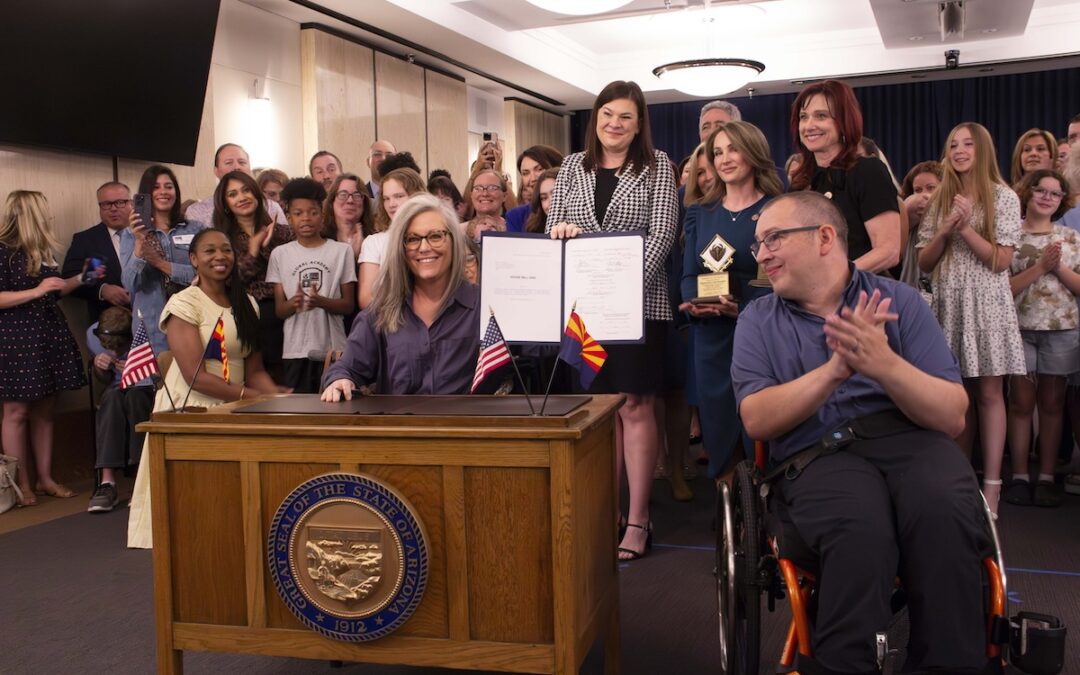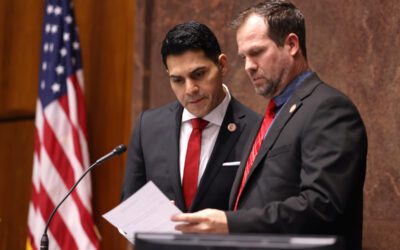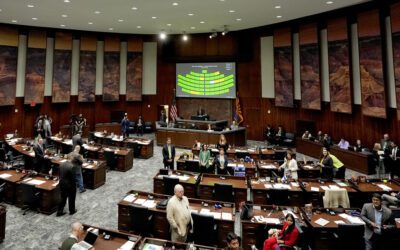
A view of the Arizona State Capitol with a bell in front. (Shutterstock Photo/Joseph Sohm)
The inner workings of Arizona’s State House and Senate can be confusing. We broke it down to be a little more digestible.
A special session this, concurrent resolution that. Every couple of weeks, there’s an uproar about an outlandish bill that gets introduced, and halfway through the year, it seems like the state government disappears altogether.
The Arizona State Legislature is a complicated government body that seems to make history and cause controversy more and more with each year that passes—yet many Arizonans don’t know what goes on behind the doors of the State Capitol.
It’s not just Arizona: fewer than 20% of Americans can name their state legislators, according to a Johns Hopkins University survey.
Here’s some information on how the Legislature works, and how to find out who represents you.
How do the two chambers of the Legislature work?
Arizona’s Legislature is considered part-time, meaning they only meet the first few months of the year. The Arizona Constitution requires the legislative session to begin the second Monday in January, which, this year, is Jan. 13, 2025.
There are a total of 90 legislators in Arizona’s Legislature—made up of 30 Senators in the upper chamber, and 60 Representatives in the lower chamber.
Arizona has 30 legislative districts, with one senator and two representatives representing each district. Both positions are elected to two-year terms, and legislators can switch between chambers to get around term-limit laws.
Find out what district you live in here, then identify who your senator and two representatives are by searching for the district they represent.
Legislators are responsible for drafting and introducing bills, voting to pass or kill bills, and debating the merits of bills. The Senate also can create laws and add amendments to the Arizona state constitution, and in conjunction with the House, the Senate approves the state’s annual budget.
Since the Legislature is only in session for part of the year, either the Legislature, the governor, or both may call special sessions after the Legislature has adjourned for the year for reasons like budget shortfalls or times of disaster (like a pandemic). In special sessions called by the governor, the Legislature may only consider matters specified by the governor.
Who holds the most power?
The 2025 legislative session will have a Republican majority, with 17 Republicans and 13 Democrats in the Senate, and 33 Republicans and 27 Democrats in the House of Representatives—meaning, Arizona’s Republican party holds most of the power.
Since Republicans secured a majority of members in each chamber, Republicans get to choose who runs committee meetings, which bills to vote on, and what the rules will be.
This year, Republicans elected Rep. Steve Montenegro to be the speaker of the House, and reelected Sen. Warren Petersen to be Senate president. In turn, Montenegro and Petersen set the committee agendas and select legislators to chair those committees.
Any legislator can write a bill, but only those in these positions get to decide whether or not a bill will be debated and voted on.
In previous years, Republicans have instituted an unwritten rule that requires Democrats secure support from a majority of Republican legislators in order for their bills to make it on the floor schedule for a vote.
This year, that means even if a Democratic legislator’s bill had support from all 14 Democrats in the Senate and all 29 in the House, they would still need support from nine Republicans in the Senate and 16 in the House.
The same standard doesn’t apply to Republicans’ bills. In 2024, Republicans had roughly 12 times as many bills receive a floor vote than Democrats.
Correction: A previous version of this article listed the incorrect number of Republicans needed to support a Democrat’s bill in order to be added to the floor schedule.
READ MORE: How can I make my voice heard at the Arizona Legislature?
Support Our Cause
Thank you for taking the time to read our work. Before you go, we hope you'll consider supporting our values-driven journalism, which has always strived to make clear what's really at stake for Arizonans and our future.
Since day one, our goal here at The Copper Courier has always been to empower people across the state with fact-based news and information. We believe that when people are armed with knowledge about what's happening in their local, state, and federal governments—including who is working on their behalf and who is actively trying to block efforts aimed at improving the daily lives of Arizona families—they will be inspired to become civically engaged.


Arizona’s rural groundwater deal stalls as legislative session nears end
PHOENIX (AP) — Arizona's governor and the GOP-controlled Legislature are at odds over regulating groundwater pumping in the state's rural areas —...

Arizona lawmakers pass last-minute lifeline for family disability services
Arizona lawmakers finally passed a bill with bipartisan support to fund the Division of Developmental Disabilities (DDD), after a months-long...

Smoking—or rather, a lack thereof—could kill this early child development program
When Kelsey Irelan moved from Illinois to Arizona with her baby girl in tow, she didn’t know what to do for childcare. The single mother visited...

Arizona Republicans are not keeping their affordability promise to voters
Nearly every Republican who ran for office in 2024 touted “affordability” as one of their top priorities—but in Arizona, most are not keeping that...





